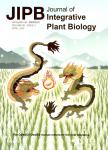Alterations of RNA Editing for the Mitochondrial ATP9 Gene in a New orf220-type Cytoplasmic Male-sterile Line of Stem Mustard (Brassica juncea var. tumida)
Alterations of RNA Editing for the Mitochondrial ATP9 Gene in a New orf220-type Cytoplasmic Male-sterile Line of Stem Mustard (Brassica juncea var. tumida)作者机构:Laboratory of Genetic Resources & Functional Improvement for Horticultural Plants Department of Horticulture Zhejiang University Hangzhou 310029 China Laboratory of Horticultural Plant Growth Development & Biotechnology Ministry of Agriculture Zhejiang University Hangzhou 310029 China
出 版 物:《Journal of Integrative Plant Biology》 (植物学报(英文版))
年 卷 期:2007年第49卷第5期
页 面:672-677页
核心收录:
学科分类:0710[理学-生物学] 09[农学] 0901[农学-作物学] 0703[理学-化学] 0902[农学-园艺学] 090202[农学-蔬菜学]
基 金:Supported by the National Natural Science Foundation of China (30571270)
主 题:ATP9 Brassica juncea cytoplasmic male sterility RNA editing.
摘 要:RNA editing for the mitochondrlal ATP9 gene of encoding regions has been observed in both cytoplasmic malesterile and maintainer lines of stem mustard, where its editing capacity varied spatially and temporally in the cytoplasmic male sterility (CMS) line. There were four RNA editing sites for the mitochondrial ATP9 gene according to Its normal editing sites in mustard, of which three sites occurred as C-to-U changes and one as a U-to-C change. As a result, the hydrophobicity of deduced ATP9 protein was reduced due to the conversions at its 17th, 45th and 64th positions. Meanwhile, the conservation of deduced ATP9 protein was enhanced by changes at the 56th position. Loss of a specific editing site for ATP9 was observed in juvenile roots, senile roots, senile leaves and floret buds of the CMS line. Comparatively, complete RNA editing for ATP9 gene was retained in juvenile roots, juvenile leaves and floret buds of its maintainer line; however, the loss of a specific editing site for ATP9 gene occurred at senile roots and senile leaves in its maintainer line. These observations allow us to produce a hypothesis that the dysfunction of a specific mitochondrial gene arising from RNA editing could probably be a factor triggering CMS and organ senescence through unknown cross-talk pathways during development.



